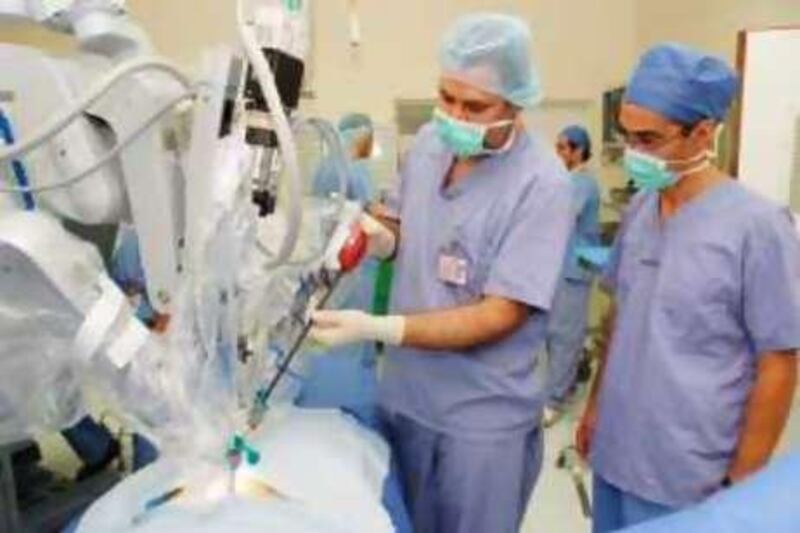DOHA // When the Qatar Foundation was choosing the elements of its future science and technology park a couple years ago, Dr Tidu Maini urged the planners to include a robotic surgery centre.
He pointed out that the new technologies minimise the physical damage to the patient and improve the effectiveness of a variety of procedures. A surgeon performing a heart bypass, for example, no longer needs to open the patient's chest and cut through rib bones. "Now you just make a few small holes and go in," Dr Maini, the head of Qatar Science and Technology Park, said during a recent interview. "The hand is clumsy and big, where as these tools are smooth and very dexterous."
More importantly, while robotic surgery centres have been popping up all over the West, none had appeared in the Middle East and North Africa. "The question is where are the big breakthroughs going to happen in the future, and it's in robotic surgery," said Dr Maini. With help from leading robotic surgeons at the Imperial College of London, Qatar Foundation launched the Qatar Robotic Surgery Centre (QRSC) earlier this year. Some 15 doctors from across the Gulf attended the centre's inaugural training session in the centre's sleek headquarters in April.
Robotic-assisted surgery leads to fewer mistakes and a greater surgical success rate, particularly as the technology improves. The question is whether the doctors who attended the training will implement the procedures they learned once they return home. A research paper published earlier this year by the QRSC lead researcher Dr Julien Nahed highlights the low use of robot-assisted surgery in the GCC. Only a few hospitals, including Doha's Hamad Medical Centre, have embraced the new technology, mostly due to the considerable expense and a lack of training.
"We're very optimistic," Dr Nahed said. "Uptake will take some time, but we have the technology and the training to make real advances in Qatar and beyond." Further training sessions of up to a week are planned for the autumn, with a range of programmes including general surgery, urology, gynaecology and cardio-thoracic surgery. The centre hopes to train as many as 300 surgeons each year. "Once the surgeon gets the confidence and understands how to manipulate the machines he will begin to do more procedures," said Dr Nahed.
The centre will bring in international experts for certain sessions, but overall training will be led by surgeons from Hamad. "They have the experience and they have the responsibility to train people in the country and the region," said Dr Tidu. QRSC's research, meanwhile, is focused on image-guided surgery and improving surgical education. Right now, technology researchers are looking at better instrumentation to facilitate the use of robotic systems. Building a better robot is better left to the engineers.
"The temptation very early on is to fiddle with the robotics part of it, but we've kept away from that," said Dr Maini. "Where we come in is to couple the robotics with instrumentation that gives you an advantage in terms of better surgical procedures." Researchers are working on a miniature magnetic resonance imaging device that can be attached to one of the robotic arms and provide real-time images of the surgery. "During a cardiac procedure you can't see what's happening behind the heart, but as you take certain steps you want to know what's going on," said Dr Maini. "This tool would allow us to do that."
To improve education, the centre is developing a comprehensive skills assessment system and, in partnership with the American University in Beirut and Texas A&M-Qatar, a more sensitive robotic surgery simulator. The main objective is to get surgeons across the Gulf to learn, embrace and implement these methods. After that, the ideas and reach of the centre will move beyond the region. "There's no point in developing a wonderful widget which nobody can use," said Dr Maini. He urged the researchers and trainers of the centre to "cut your teeth on something local and then you use the momentum to carry you forward".
QRSC has four full-time staff as of mid-June, but that number is set to increase. Research projects will begin after Ramadan. In October, QRSC plans to launch an internship programme to give talented students hands on research experience. Finally, the centre has begun gathering the brightest Qatari surgeons and scientists into a national network on surgical technology. Within a few years, Dr Maini sees QRSC vastly improving the quality of surgeons, and surgery, across the region. "There will be a tremendous impact and I think it will happen automatically," he said. "New technology has a faster uptake here than in traditional countries like England or France."
@Email:dlepeska@thenational.ae






